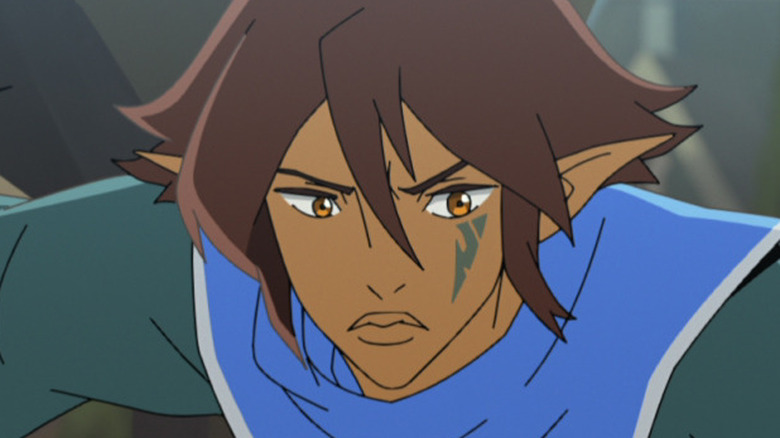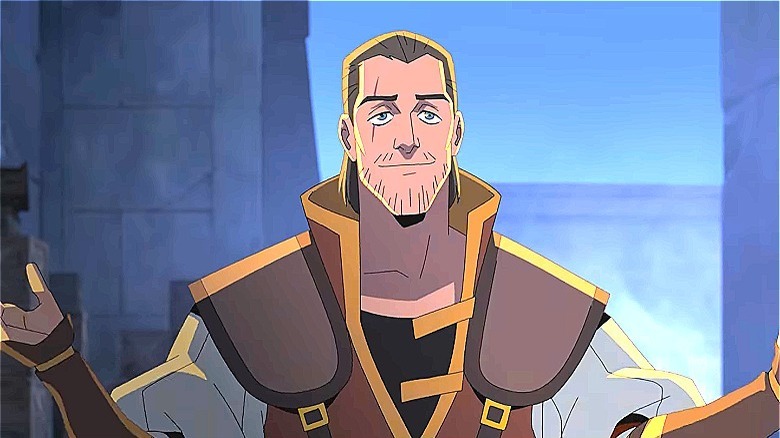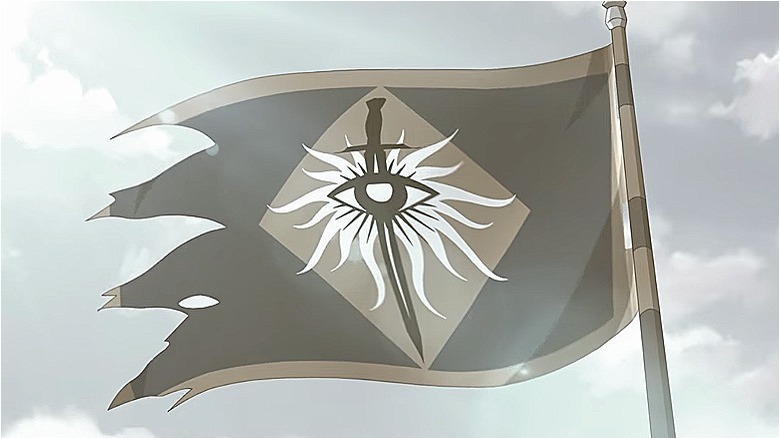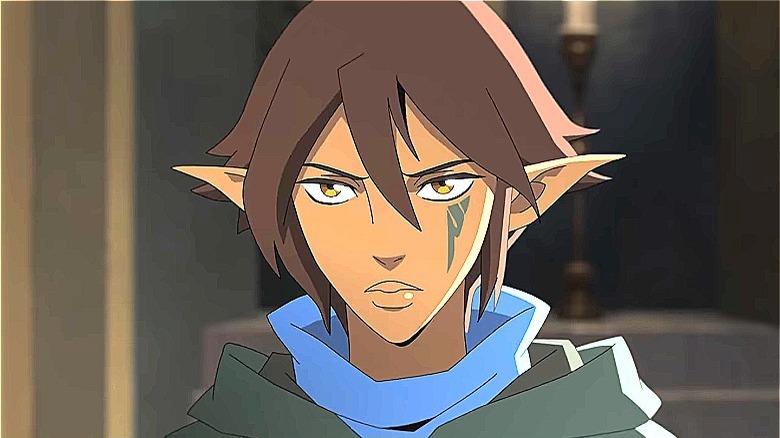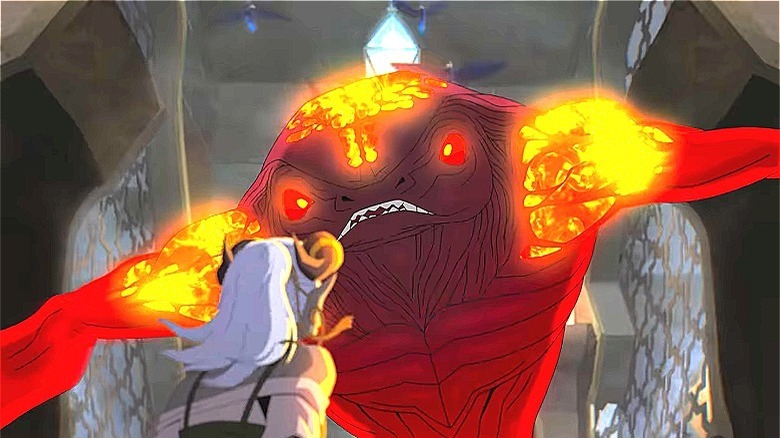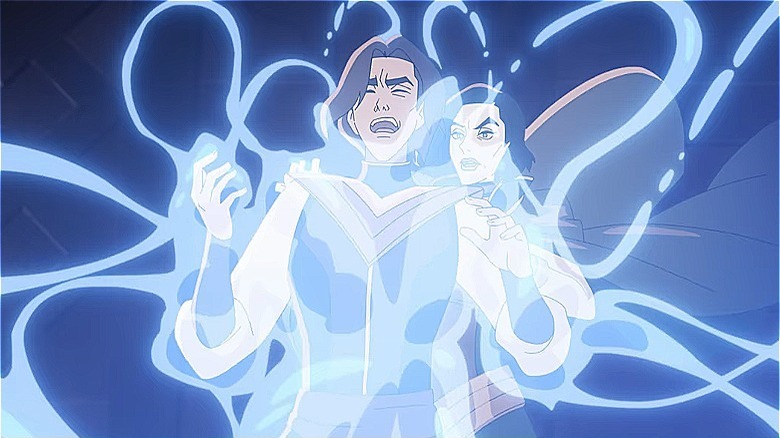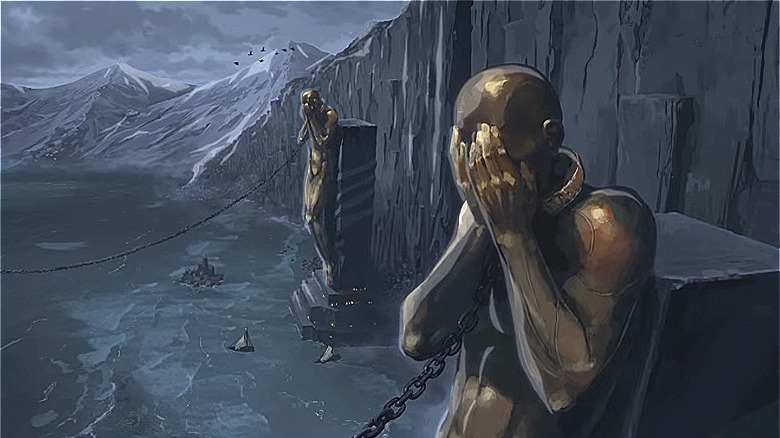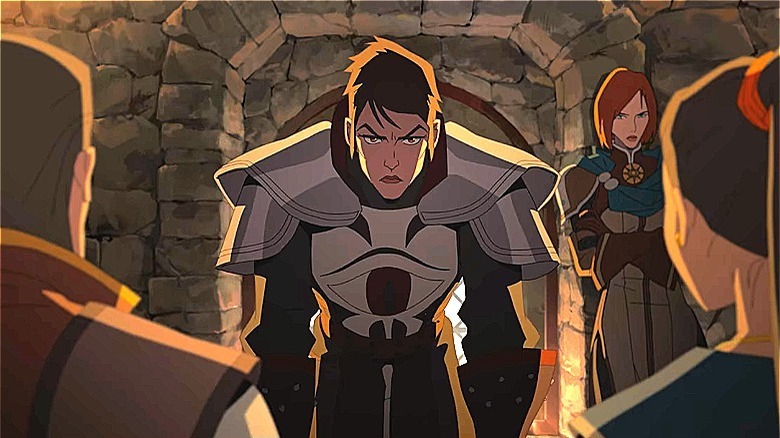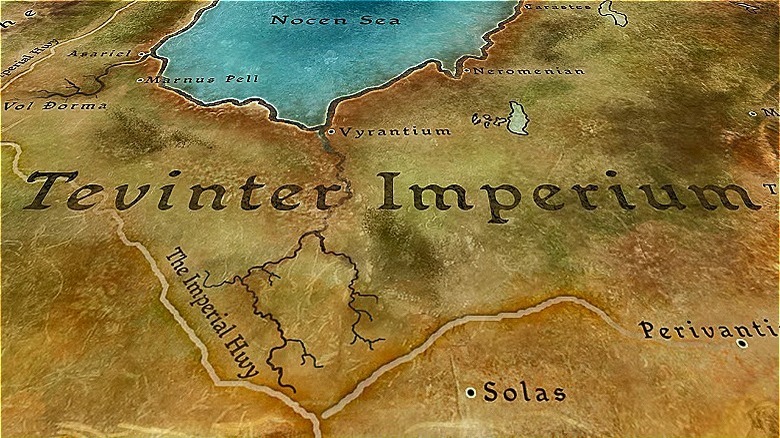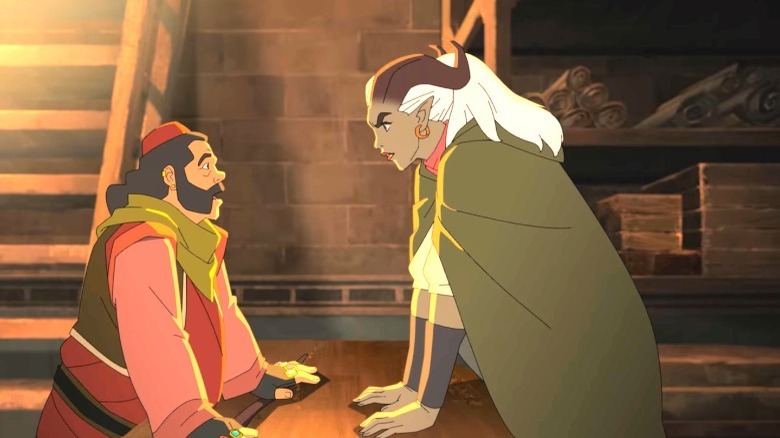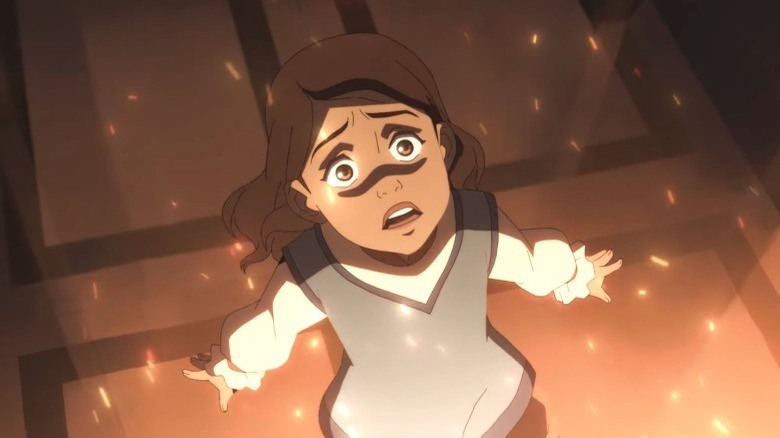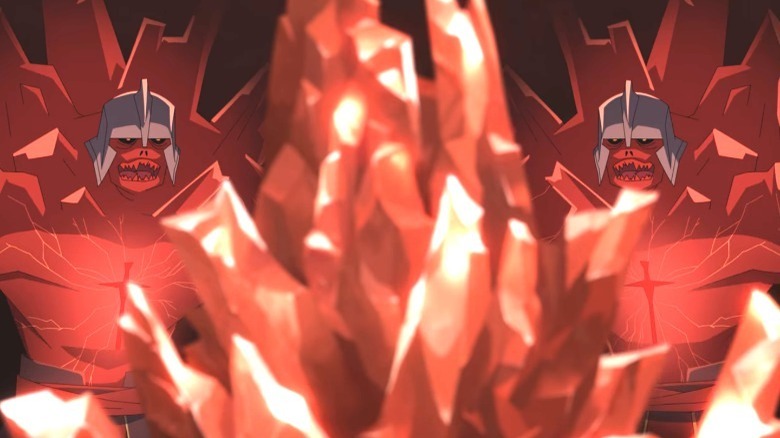Small Details In Dragon Age: Absolution That Only Fans Of The Games Will Notice
While this year's Game Awards featured news about many anticipated upcoming titles, one game that was sadly absent was "Dragon Age: Dread Wolf," the fourth installment of the beloved BioWare franchise. Luckily, fans were able to slake their thirst for the fantasy RPG with the limited Netflix show, "Dragon Age: Absolution." The six-episode animated series tells the story of a ragtag group of thieves attempting to pull off a dangerous heist in the magic-ruled kingdom of Tevinter, set in the "Dragon Age" world of Thedas.
The show's lead character, an elf named Miriam (Kimberly Brooks), is a savvy rogue and a fugitive on the run. She and her partner Roland (Phil LaMarr) are approached by a man named Fairbanks (Matthew Mercer) and Hira (Sumalee Montero), a human mage. Hira is Miriam's old flame, and she and Fairbanks are members of an order called the Inquisition. They need Miriam to assist them in stealing a powerful magical artifact called the Circulum Infinitus, an item that can supposedly bring the dead back to life. Unfortunately, joining their cause means that Miriam will be forced to face her traumatic past — including her former life as a slave.
"Dragon Age Absolution" is chock-full of references to the video game franchise, which may leave some viewers feeling a bit out of the loop. Here are some of the details in the series that die-hard "Dragon Age" fans will notice, but some might need a little bit more explanation.
Fairbanks originally appeared in a Dragon Age game
The man leading the heist in "Dragon Age: Absolution" is Fairbanks, a clever thief and master safecracker. He and Hira were both members of the Inquisition, an order headed by the Herald of Andraste that has since been disbanded. They set up a job for Miriam's mercenary group to test her skills and see if she is capable of helping them with their true mission. However, when Fairbanks and Hira do find the object they are looking for, things don't go as planned. Fairbanks betrays Hira, stabbing her in the back, and later dies from fatal wounds. His so-called betrayal isn't what it seems, however, as Miriam discovers in the final episode.
This isn't the first time that "Dragon Age" fans have met Fairbanks. He also appears in the 2014 video game "Dragon Age: Inquisition" at Emerald Graves, where he is the leader of a camp of refugees seeking solace from a civil war. He asks for help to rid the area of enemies known as Freeman of the Dales, a group of revolutionaries who kill indiscriminately for their cause. Following this, Fairbanks decides to join the Inquisition.
There is also a side quest in the game in which it's revealed Fairbanks is of noble descent. His real name is Everiste Lemarque, and a journal entry reveals that his mother had him in secret. Unfortunately, his fate in "Absolution" means that we aren't likely to see him in any future games.
The fate of the Inquisition
In the first episode of "Absolution," Fairbanks and Hira reveal they work for the Inquisition. They claim the group has disbanded, however, they are still working for the last remaining members of the order. According to Fairbanks, they need the Circulum Infinitus because it is too powerful to leave in the hands of the Tevinter Imperium.
The Inquisition originates from the third "Dragon Age" video game and is led by the player character (also called the Inquisitor, or the Herald of Andraste), founded by members of a religious order known as the Chantry. The order's sole purpose is to find out what caused a cataclysmic magical hole in the sky (called the Breach) and put an end to the evil behind it.
One of the facets of the "Dragon Age" series that attracts so many gamers is the power of choice. In several instances, the hero can alter the outcome of the story depending on the decisions they make throughout the game. Once the main "Inquisition" storyline has been completed, the tale continues with the DLC, "Trespasser." At the end, the player must make a crucial decision: whether to keep the Inquisition going, or let it dissolve.
In "Absolution," it appears that the series' writers oped to disband the Inquisition. How or why there are members of the order still working under the Inquisition's banner is not explained, but it's possible that the gaps might be filled in the upcoming "Dread Wolf" game.
Tevinter's history with slavery
Like many elves in Tevinter, Miriam and her brother, Neb, were slaves. Miriam eventually escaped, yet continued to be burdened by painful trauma. At first, she refuses to help Fairbanks and Hira steal the Circulum, as it would mean facing the very family that once viewed her as property. However, the prospect of living a peaceful life with the woman she loves is too good to pass up. Miriam decides to face her fears and agrees to join the heist.
According to "Dragon Age" lore, the Tevinter Imperium has a long and shameful history of owning and trading slaves. It is also the only country in the land of Thedas to practice the sordid tradition. In the early days of Thedas' history, the mages of the Imperium went to war with the elves of a land called Arlathan. With the help of blood magic, and summoning demons to their side, the mages managed to destroy Arlathan and enslave the elves who survived. One of the most famous slave uprisings involved the human warrior, Andraste, who nearly overthrew the Tevinter empire but was eventually caught and executed. Andraste's fight against the Imperium inspired the founding of the Chantry, a religious order that worshipped her as a prophet.
Despite Tevinter's eventual conversion to the Andrastian religion, its leaders continued to maintain the use of slaves and the slave trade. This despicable practice is just one reason that the rest of Thedas has remained estranged from the Imperium.
Familiar enemies
In a land of magic, there are sure to be many terrifying monsters to contend with — and not just dragons. In "Dragon Age: Absolution," we get to see a few of those creatures firsthand. The first appears when Rezaren (Josh Keaton), a Tevinter magister, summons a spirit to question its knowledge of the Circulum Infinitus. When Rezaren tries to force answers from the spirit, it transforms into a giant demon.
Players of the "Dragon Age" games will recognize the Pride Demon as one of the most formidable enemies of the series. All three games have featured a Pride Demon in various forms, and each one is a challenge to defeat. Its appearance is followed by a series of other frightening creatures who attack Rezaren and the knight, Tassia (Zehra Fazal). These demon hosts are called shades, and they, too, are regular enemies that the player confronts in all three games.
In a later scene, the Qunari mage, Qwydion (Ashly Burch), has to run for her life against a fiery lava monster known as a Rage Demon. "Dragon Age" fans will also remember it as one of the toughest enemies from the game series.
A Harrowing gone wrong
In Episode 4 ("Those Who Falsely Dream"), we learn more about Miriam and Rezaren's shared past. As Miriam lay unconscious and bleeding out, Rezaren appears in her dreams. He tries to manipulate her by showing her fond memories of their childhood, but Miriam recalls things differently. She reminds Rezaren of the day that he went through a dangerous ritual that resulted in disaster. Rezaren's failure nearly causes him to be possessed by a demon, but his mother saves him by transferring the demon to Miriam's brother, Neb. Miriam then kills her possessed brother and Rezaren's mother, forcing her to become a fugitive.
The ritual that Rezaren is conducting in this scene is known as a Harrowing – a right of passage for all mages in the "Dragon Age" world. During this test, the mage must enter a place called the Fade; a land of dreams, and also the home of spirits and demons. While the mage's consciousness is within the Fade, they must confront a demon and overcome it. If they complete the test, they succeed. If not, they become possessed and are put to death.
Harrowings are an important part of "Dragon Age" lore, especially if the player chooses the mage class. It is a test of both magical skill and psychological strength. The fact that Rezaren was unable to complete the Harrowing on his own says a lot about his character, and perhaps explains why he is so easily enticed by dark magical practices.
The Hanged Man in Kirkwall
Within every fantasy world is a plethora of lore, including names, places, and history. It can be tough to keep it all straight, and easy to let certain details slip by without notice. In Episode 3 ("The Serpent's Coils"), things go awry when a betrayal is discovered in the ranks. Miriam finds Hira in a magical cell and attempts to free her, but is unsuccessful. Hira secretly instructs Miriam to take the artifact to the city of Kirkwall to a place called The Hanged Man where her contact is waiting.
To casual viewers, names like Kirkwall and The Hanged Man don't mean a thing. But for those who have played the "Dragon Age" games, they mean a lot more. "Dragon Age II," released in 2011, takes place almost entirely in Kirkwall. The Hanged Man is a popular tavern within the city where many important events of the game take place.
The player can go to The Hanged Man whenever they want to hear the latest gossip from the bartender or just relax and have a drink. It's also the favorite hangout of two of the player's companions: Varric, a dwarf, and Isabela, a swashbuckling pirate. Although Hira doesn't initially reveal the name of her contact in "Dragon Age: Absolution," The Hanged Man in Kirkwall offers a big clue for those who recognize them.
The members of the Inquisition
With the exception of Fairbanks, "Dragon Age: Absolution" features brand new characters to the franchise that are not in the games. However, there are a few cameos and mentions that game fans will be sure to spot. As Fairbanks explains their mission to the group in Episode 1 ("A Woman Unseen"), he mentions Cassandra Pentaghast (Miranda Raison). The scene then cuts to a woman in dark armor speaking to Fairbanks and Hira, while another leans against the wall behind her.
Cassandra is a notable character from the "Dragon Age" games. She first appeared as a minor character in "Dragon Age II" and later becomes a companion in "Dragon Age: Inquisition." Cassandra is a Seeker, which is an order of magical knights that work for the Chantry. She was one of the original founders of the Inquisition and played a big role in its activities.
The other woman is Leliana, a bard-turned-spy. She is a companion of the player character in 2009's "Dragon Age: Origins," and also has an important role in "Dragon Age: Inquisition." Those who have played the games will also recognize the very brief cameos of two other Inquisition members in Episode 6 ("The Price of Salvation") — Josephine, the Inquisition's ambassador, and Cullen, the captain of the Inquisition's army.
The city of Solas
During their journey to Tevinter in the first episode of "Dragon Age: Absolution," Fairbanks explains the history of the Imperium to the rest of the group. During this montage, we see the vast deserts and lush jungles of the landscape as they travel, followed by a shot of a map of the Tevinter Imperium. On the map we see the Nocen Sea, a road labeled The Imperial Highway, and various cities such as Vyrantium and most notably, Solas. Why is Solas so notable? Well, although the "Dragon Age" games haven't given us much information about the city, it shares a name with one of the most important characters in the entire franchise.
Solas is an elf mage who was first introduced in "Dragon Age: Inquisition" as one of the player's companions and a possible love interest. It turns out that Solas is more than the carefree wanderer he appears to be — his true name is Fen'Harel, also known as the Dread Wolf, and he is a powerful god of Elvhen lore.
As the players learn in the "Inquisition" DLC, "Trespasser," Solas created the Veil — the boundary between the waking world and the Fade — and reveals his plans to destroy it, thus allowing spirits and demons to roam freely. This will surely mean the destruction of all mortal beings and sets up the events of the upcoming "Dragon Age: Dread Wolf," with Solas as the game's likely antagonist.
The Blight
In "Dragon Age: Absolution," everyone on the heist team is given a job. One of the group members is Qwydion, a sweet-tempered mage from a race known as the Qunari. To prepare for the upcoming heist, Qwydion disguises herself as a slave and goes to gather supplies from a local merchant. Her shopping list includes a number of dangerous magical tools, which naturally raises the merchant's suspicions. Qwydion comes up with a clever lie, telling the merchant in hushed tones that her master is preparing for an impending Blight. The merchant easily falls for the ruse and even offers her a look at his special stash.
For some, the Blight might be mistaken for the name of a nasty plague, but "Dragon Age" gamers know that it is much more than that. The Blight has been a threat to Thedas for centuries, and its origins are steeped in mystery. During a Blight, an evil army of creatures called darkspawn emerges from underground and spreads destruction and pestilence among every race of mortals. The only way to fight it is by killing the leader, an ancient corrupted dragon known as an Archdemon.
In the first game, "Dragon Age: Origins," putting an end to the Blight is the goal of the player character. However, it can never be fully stopped, and the cycle eventually starts over again, making it an ever-present danger to the people of Thedas.
The Venatori
Miriam isn't the only one in "Dragon Age: Absolution" with a tragic backstory. Her girlfriend, Hira, is also the victim of a tragic past. It was these events that motivated the mage to betray not only the Inquisition's cause but also the woman she loves.
While being interrogated by Tassia in Episode 5 ("The Altar of Fire"), Hira tells the story of how her family was murdered by a cult of Tevinter mages called the Venatori. This caused a burning hatred inside of Hira for all of Tevinter, even those not involved with the Venatori. In the final episode, Miriam discovers Hira's betrayal and her intention to steal the Circulum Infinitus in order to destroy the whole of the Tevinter Imperium.
This is not the first time that "Dragon Age" fans have heard of the Venatori. The dangerous cult of mages is featured in "Dragon Age: Inquisition," as players face a number of its members in the game. The Venatori are extremists who wish to return Tevinter to its former glory before the Chantry took power over the Imperium. During "Inquisition," the Venatori become followers of Corypheus, the game's main villain, and worship him as a God.
The Crimson Knight
After Hira's true intentions are revealed in the last episode of "Absolution," Miriam gives her the chance to choose her over the Circulum. Hira chooses the latter before making a magical escape, but Miriam isn't worried. She tells the rest of the group that she knows Hira's next destination: the city of Kirkwall.
As the team heads out, the scene cuts to the ominous exterior of Kirkwall. We then see a fortress atop high cliffs before cutting to the fortress's interior. In a large hall, an armored knight adorned in red crystals addresses someone — or something — on a throne. He appears to be talking to a giant red crystal, relaying news of Hira and the agents pursuing her. A commanding woman's voice speaks from within the shards and ominously instructs her minions to kill the agents. "I will have my war," she declares, before the screen turns to black.
This strange being is none other than the Crimson Knight, the contact that Hira mentioned in an earlier episode. But "Dragon Age" fans also know her by another name: Knight Commander Meredith. She is the big baddie at the end of "Dragon Age II," and though she begins as a regular human, she is corrupted by an evil artifact that causes the red crystals (or red lyrium) to protrude from her body. Although she was seemingly defeated at the end of the game, it looks like Meredith survived — albeit in a new and terrifying form.
